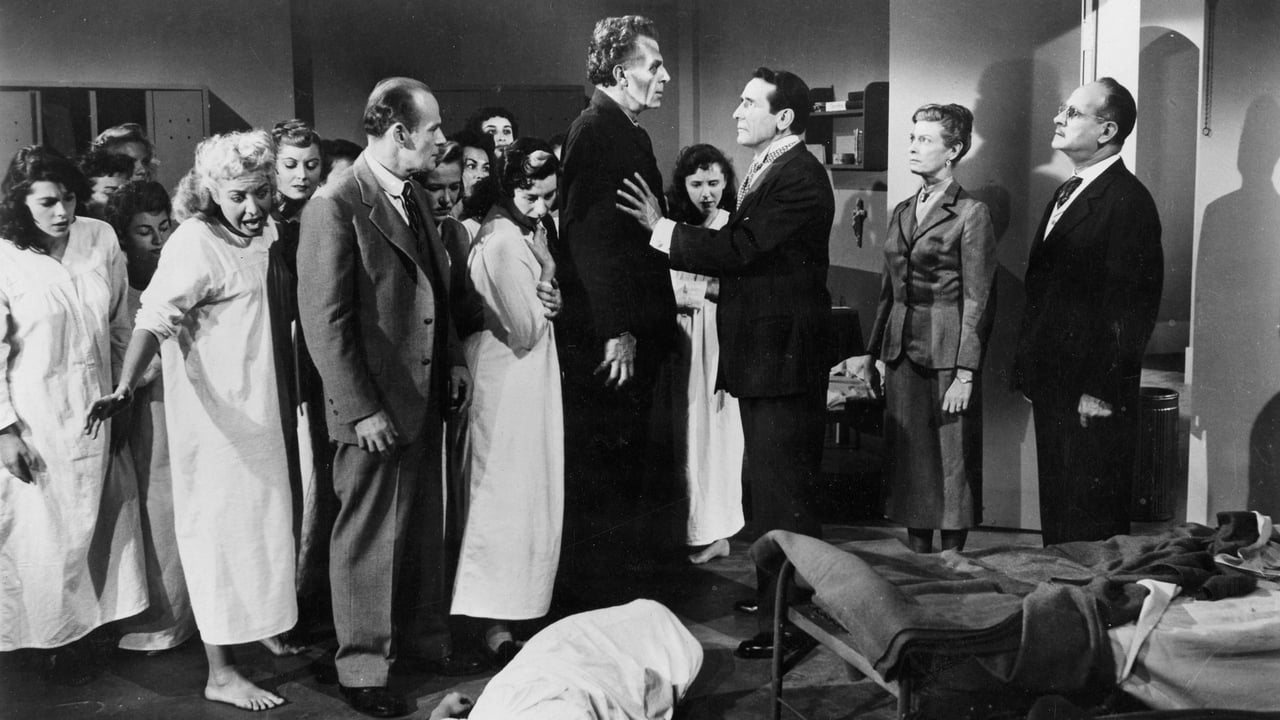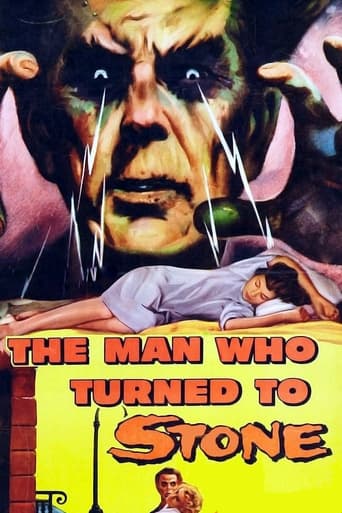mark.waltz
Within five minutes of this movie starting, I knew that I was in the process of watching one of the most wretched pieces of celluloid ever to be captured on film. Every tedious B movie cliché is present, from a women's prison setting to lame dialog (so bad it sounds like it was written by an elementary school student) and truly wretched acting from a cast of some professionals and some not so professional. I had to keep reminding myself that I was not watching an early John Waters film where the actors had been directed to over-play it broadly. While the film lasted only 71 minutes, I felt that it seemed closer to two hours. I have never wanted to see "The End" pop up as much as I did here. I don't always agree with Leonard Maltin, but he gave this a bomb, and I agreed only because there is not a negative rating system.Looking like he's covered in plaster of Paris, Friedrich von Ledebur sulks through this film looking like Boris Karloff's corpse a week after his death. He is revealed to be two centuries old and Victor Jory's mad doctor Murdock is researching a way to keep him alive. There's no motivation for it, and along with his bird-like assistant (Ann Doran made up to look as coldly plain as possible), female inmates of this minimal security prison are utilized for their purposes. These young ladies are purposely incorrectly diagnosed with heart conditions to explain their sudden "death by natural causes", but when von Ledebur begins to get more desperate, he begins to break into the woman's dormitory to collect a human guinea pig for the experiment.It's up to Charlotte Austin's assistant (hired obviously against the will of Jory and Doran to ensure the inmate's continued mental well being) and handsome doctor William Hudson to expose the evil goings on here, and this leads to a fiery showdown. Frankly, I wanted hideous death scenes for Jory, Doran and von Ledebur (whom I hoped would suddenly break into a million pieces with his stony face) but even that didn't occur. The film is so overloaded with ridiculous dialog that didn't even have the decency to be unintentionally unfunny. Whoever approved this piece of garbage being made should have been instantly canned by Columbia and the film immediately shelved. At least this probably did have the good taste into playing at a drive-in where at least the teen-aged audience was forewarned so they could make out through the showing.
lemon_magic
More of a horror movie set in a "girl's home" than a science fiction movie, with definite exploitation elements, "Man" seems to be built around the scenes where "Eric" grabs the young women and carries them off to the upstairs lab to be tied up, gagged, and drained of their "bioenergies".You'd think a movie with several scenes like that would be cheaply thrilling and maybe a guilty pleasure, but you'd be wrong. The movie is mostly too too dull to keep any interest. The "girls" all seem to be in their late 20's and 30s (I know, it's really hard to get teenagers to look and act believably for extended lengths of movie time) and a couple of them are OK, but none of them are there for any reason but to be kidnapped and victimized.There's one nicely underplayed scene where the scientist/torturers decide withhold the bioelectric treatments from one of their number for reasons that aren't completely clear. The actor playing the dying scientist manages a dignified and believable farewell and you can see how interesting the film might have been if the director and screenwriter had the wherewithal to explore the group dynamics and interplay of a group of 200+ year old bioelectric vampires.To top it off, the hero "wins" because one of the scientists accidentally drops a candle into a box of rags while changing the fuses or something and within seconds the whole building is engulfed. Stupidest. Villains. Ever.Victor Jory is decent in this - you can see even here why the man could continue to get work in films over the years.Not good, not all that bad, "Man Who Turned To Stone" is just...there. If you get a chance to see it, it'll be OK and you won't hate it. But I doubt you'll remember much of it the day after.
zardoz-13
"Small Town Girl" director László Kardos' superficial horror chiller "The Man Who Turned to Stone" qualifies as nonsense from fade-in to fade-out. This inept, outlandish yarn about an ill-fated group of 18th century scientists that have learned to preserve themselves despite the passage of time resembles a vampire movie. Alas, these ordinary-looking evildoers here wind up being far less interesting than vampires. They have survived for 200 years and the secret of their longevity lies in renewing the life energy in themselves by draining it away from helpless, young women. Dr. Murdock (Victory Jory of "The Green Archer") and his associates, including Dr. Freneau (George Lynn of "The Werewolf"), Dr. Cooper (Paul Cavanagh of "The Scarlet Coat"), Dr. Myer (Victor Varconi of "The Hitler Gang"), Mrs. Ford (Ann Doran of "The Crimson Key"), and Eric (Frederick Ledebur of "The Blue Max") conduct unethical, illegal experiments on young ladies to keep themselves alive, but the poor girls perish each time.Writing under the pseudonym of Raymond T. Marcus, blacklisted scenarist Bernard Gordon has contrived a cretinous fright flick for undiscriminating audiences. "The Man Who Turned to Stone" is nothing like Gordon's better known scripts, among them: "The Battle of the Bulge," "Circus World," "Custer of the West," and "55 Days in Peking." Instead, this half-baked, lackluster horror effort recalls his work on "Zombies of Mora Tau" and "Earth Vs. Flying Saucers." Unfortunately, Gordon doesn't provide any back history for the villains and their success at maintaining a low profile after two centuries.Somehow, Dr. Murdock and his accomplices have taken over the administration at LaSalle Detention Home For Girls. Mysteriously, girls start screaming at night, disappear in the arms of tall lumbering Eric, and autopsies later reveal that the girls have died of heart failure. A young, idealistic social worker, Carol Adams (Charlotte Austin of "Gorilla At Large"), looks into the mysterious disappearances after her conspiracy theory inmate secretary Tracey (Jean Willes of "Ocean's Eleven") brings up the issue. Murdock and stern Mrs. Ford refuse to let Miss Adams review the death certificates. Things go awry for Murdock and company when they kill a young inmate, Anna Sherman (Barbara Wilson of "Teenage Doll"), to renew Eric's life energy, and then they hang Anna's body from the rafters of her dormitory while the rest of the girls are out watching a movie in another building. Tracey fumes with outrage about Anna's alleged suicide. "She could no more have committed suicide than she could have flown over the fence." Miss Adams finds it difficult to believe, too, but she finds Jean's claims just as inconceivable. "Tracy, will you stop plaguing me with your insane suspicions," she demands. "If a girl has a heart attack, it's a plot. If a girl hangs herself, it's a plot." Nevertheless, Tracy argues that Anna was not suicide inclined since she had a year to serve on her sentence, a baby awaiting her in the free world, and plans.At the inquest, Miss Adams questions the coroner's findings. Murdock tries to discredit Adams. After all, she has only been on the job for three months. Unexpectedly, Adams finds a friend in state department of mental health psychiatrist, Dr. Jess Rodgers (William Hudson of "Battle Hymn"), who decides to investigate her suspicions himself. Adams is packing her belongings when Rodgers convinces her that he will get to the bottom of this mystery that has resulted in the deaths of eleven inmates. Eventually, Dr. Rodgers receives help from the least expected person: Dr. Cooper. For a long time now, Cooper has wrestled with conscience about Murdock's skullduggery. Lately, they have been struggling to keep Eric from turning to stone, but each treatment has exerted less impact on his system. Dr. Cooper condemns Eric as 'a senseless brute' and argues that they should sacrifice him. Murdock and the others ostracize Cooper, and he dies by literally turning to stone. Before his death, however, Dr. Cooper has reveals to Dr. Rogers the location of his secret journal. Cooper's journal contains the complete and infamous exploits of Dr. Murdock and company.The villains in "The Man Who Turned to Stone" aren't very smart. They dispatch one of their own, Eric, to fetch the girls from the reformatory. Every time he abducts a girl, she screams at the top of her lungs and awakens half of the inmate population. Clearly, these sophisticated physicians have never considered giving these girls with a sedative so that they create fewer problems. Aside from the outdoor scenes where Dr. Rodgers uncovers Cooper's hidden journal, "The Man Who Turned to Stone" occurs largely inside the women's reformatory. The most gruesome scene is the suicide by hanging. Kardos shows Anna's body only from the legs down as she hangs from the rafters in a dormitory.Kardos and Gordon had the makings of good, grisly horror chiller, but they don't take advantage of those elements. The horror here lies primarily in Eric lurching about the premises looking for women for Murdock's experiments. The girls scream, but offer little resistance once Eric has them in his clutches. Although the prison is called a Detention Home for Girls, all of the girls look far too old to pass as teenagers. Of course, this is a convention that has plagued most movies about teenagers: namely, actors and actresses twice their age play these kids. The make-up looks spooky enough, but adequate make-up doesn't make a solid, scary movie. Veteran lenser Benjamin Kline's atmospheric black & white photography gives "The Man Who Turned to Stone" more credibility than the Gordon screenplay. Kline photographed over 324 movies and TV shows, so by the time that he did this movie, he could shoot in his sleep and make anything look credible. Unfortunately, a shortage of suspense, provocative villains, and anything remotely horrific—though it might have been considered horrific at the time—undermines this B-movie thriller. Only die-hard horror fans slumming for material will enjoy this forgettable movie.

